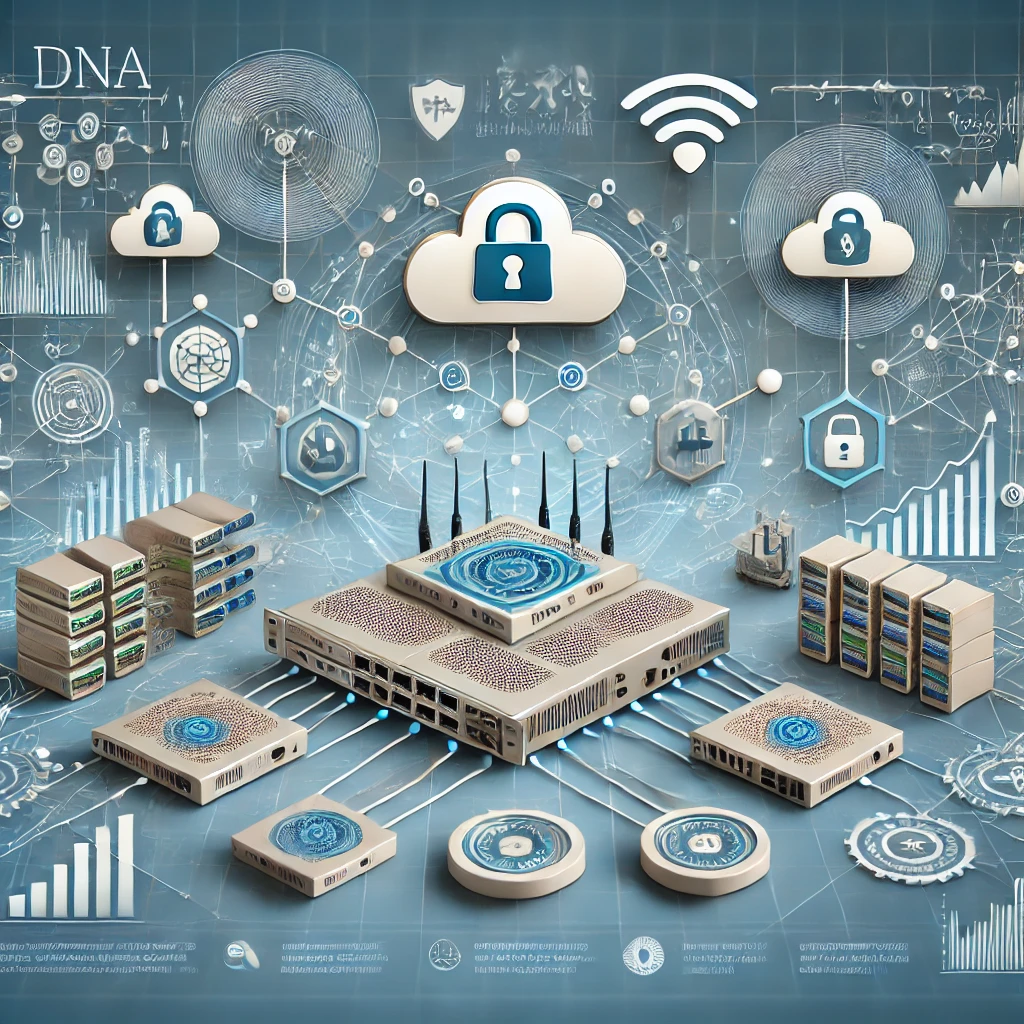What is Digital Network Architecture? A Guide to Modern Network Design
Digital Network Architecture (DNA) refers to a framework or blueprint that outlines the structure, organization, and functionality of a digital network within an organization. This approach to network architecture integrates multiple technologies and software systems to create an efficient, scalable, and secure network that can adapt to the needs of modern digital enterprises. With the rise of cloud computing, IoT, and AI-driven applications, digital network architecture enables organizations to deploy and manage complex networks in a streamlined manner.
This post will cover the components, goals, benefits, and challenges of digital network architecture, along with how it is transforming networking in today’s digital landscape.
1. Purpose of Digital Network Architecture
Digital network architecture is designed to address the needs of modern organizations that rely heavily on digital applications and connectivity. It allows for centralized management and automation of network functions, simplifying tasks such as configuration, monitoring, and troubleshooting. DNA focuses on enabling high levels of security, scalability, flexibility, and adaptability in a network environment.
Key Purposes of Digital Network Architecture:
- Simplified Network Management: DNA provides centralized control, allowing network administrators to manage and configure the entire network from a single interface.
- Scalability and Flexibility: DNA enables networks to scale up as an organization grows, supporting more devices, users, and applications.
- Enhanced Security: DNA integrates security at every level, making it easier to implement access control, monitor threats, and ensure compliance.
2. Core Components of Digital Network Architecture
Digital network architecture comprises various components that work together to build a cohesive and resilient network. Here are the primary components:
a. Software-Defined Networking (SDN)
SDN separates the network control plane from the data plane, allowing administrators to manage network resources through software rather than hardware. This approach provides greater flexibility and enables administrators to dynamically adjust network resources in response to changing requirements.
b. Network Automation and Orchestration
Automation and orchestration tools allow network tasks—such as configuration, deployment, and maintenance—to be performed automatically. These tools simplify repetitive tasks, reduce human error, and ensure network changes are consistently implemented across the network.
c. Security Integration
Security is a crucial component of DNA. Modern network architectures integrate security solutions at every layer, from firewalls and intrusion detection systems to endpoint security measures. DNA often includes features like Network Access Control (NAC) and Zero Trust Architecture (ZTA) to prevent unauthorized access and mitigate potential threats.
d. Cloud Integration
Digital network architecture often incorporates cloud services, allowing data and applications to flow seamlessly between on-premises networks and cloud platforms. This integration supports hybrid and multi-cloud environments, enabling organizations to leverage the scalability and flexibility of cloud computing.
e. Analytics and Monitoring
Continuous network monitoring and analytics provide visibility into network performance, user behavior, and potential issues. These insights allow administrators to optimize network performance, troubleshoot problems, and proactively address security threats.
f. Edge Computing and IoT Connectivity
Digital network architectures are designed to handle a large volume of data generated by IoT devices and edge computing solutions. They enable data processing at the network edge, reducing latency and ensuring efficient data handling for real-time applications.
3. Benefits of Digital Network Architecture
Digital network architecture brings several advantages to organizations by aligning network capabilities with modern business needs.
a. Simplified Management and Configuration
By centralizing network control, DNA reduces the complexity of network management. Network administrators can configure devices, apply policies, and troubleshoot issues from a single platform, making network management more efficient.
b. Scalability and Future-Proofing
With DNA, networks can easily scale to accommodate growth in user numbers, devices, and applications. This scalability ensures that the network remains capable of supporting future needs, including emerging technologies like AI and IoT.
c. Enhanced Security and Compliance
DNA frameworks incorporate security at every layer, enabling organizations to enforce consistent security policies across the entire network. Integrated security features make it easier to monitor for potential threats and ensure regulatory compliance.
d. Increased Agility and Flexibility
Digital network architectures allow organizations to adapt quickly to changing demands. With features like SDN and cloud integration, networks can dynamically adjust resources based on traffic, application requirements, or user needs.
e. Cost-Effectiveness
By reducing manual tasks through automation and enabling efficient resource allocation, DNA can help organizations cut down on operational costs. Additionally, the flexibility to use both on-premises and cloud resources provides cost-effective options for network expansion.
4. Challenges of Implementing Digital Network Architecture
While DNA offers numerous advantages, there are challenges that organizations may face during implementation:
a. Complexity of Transition
Transitioning from a traditional network to a digital network architecture requires careful planning and execution. The process can be complex, involving hardware upgrades, software integration, and employee training.
b. Security Risks in Hybrid Environments
DNA often involves integrating on-premises infrastructure with cloud services, which can expose the network to security risks if not managed properly. Organizations need to invest in comprehensive security strategies to mitigate these risks.
c. Cost of Implementation
Although DNA can lead to long-term savings, the initial costs of upgrading infrastructure, implementing automation tools, and training staff can be substantial. Smaller organizations may find these costs challenging to manage.
d. Skilled Workforce Requirements
Implementing and managing digital network architecture requires expertise in areas like SDN, cloud technologies, and network security. Finding qualified staff or upskilling existing employees is often necessary.
5. Examples of Digital Network Architecture Solutions
Several technology providers offer comprehensive digital network architecture solutions designed to meet modern networking needs. Some popular examples include:
- Cisco Digital Network Architecture (DNA Center): Cisco’s DNA Center is a centralized platform that provides tools for SDN, network automation, and security, designed to simplify network management and improve performance.
- VMware NSX: VMware NSX offers a software-defined networking solution that includes network virtualization, security, and automation for data centers and cloud environments.
- Microsoft Azure Virtual WAN: Microsoft’s Azure Virtual WAN is a networking solution that enables businesses to connect on-premises infrastructure with Azure cloud resources, supporting a hybrid cloud environment.
6. Future Trends in Digital Network Architecture
As technology continues to evolve, DNA is expected to incorporate more advanced features and become even more integrated with emerging technologies:
a. Increased Use of Artificial Intelligence
AI and machine learning algorithms are expected to play a significant role in DNA, providing intelligent automation, predictive analytics, and enhanced security monitoring.
b. Expansion of Edge Computing
With the growth of IoT and real-time data applications, DNA will increasingly focus on edge computing, processing data closer to the source and minimizing latency.
c. Enhanced Security Through Zero Trust
Zero Trust Architecture (ZTA) is becoming a core security feature in DNA. By enforcing strict access controls and verifying every access request, ZTA enhances protection against internal and external threats.
d. Integration of 5G Networks
The arrival of 5G technology will require DNA to adapt to the increased network speed and device connectivity. 5G will enable faster, more reliable networks, particularly for IoT devices and high-bandwidth applications.
Conclusion
Digital Network Architecture is transforming how organizations build, manage, and secure their networks. By integrating SDN, automation, cloud, and security features, DNA enables a highly adaptable, efficient, and resilient network structure that meets the demands of modern digital enterprises. Although the transition to DNA requires investment and expertise, the benefits of scalability, simplified management, and enhanced security make it a vital asset for future-focused organizations.
As digital transformation continues to drive innovation, digital network architecture will remain a cornerstone in helping organizations leverage the full potential of their networks to support productivity, growth, and secure connectivity.






